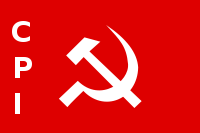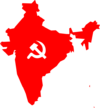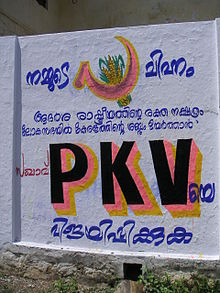- Communist Party of India
-
Coordinates: 28°37′54.01″N 77°14′17.15″E / 28.6316694°N 77.2380972°E
Communist Party of India Secretary-General A.B. Bardhan Founded 1920
Tashkent, Turkestan Autonomous Soviet Socialist RepublicHeadquarters Ajoy Bhavan
Comrade Indrajeet Gupta Marg
New Delhi, India
110002Newspaper New Age (English),
Mukti Sangharsh (Hindi),
Kalantar (Bengali),
Janayugam daily (Malayalam)Ideology Communism International affiliation International Conference of Communist and Workers' Parties. Alliance Left Front Election symbol 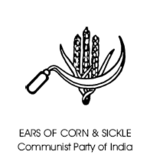
Website http://www.communistparty.in/ Politics of India
Political parties
ElectionsThe Communist Party of India (CPI) is a national political party in India. In the Indian communist movement, there are different views on exactly when the Indian communist party was founded. The date maintained as the foundation day by CPI is 26 December 1925. But the Communist Party of India (Marxist), which separated from the CPI, claims that the party was founded in 1920.
Contents
Communism during the colonial period
The Communist Party of India was founded in Tashkent, Turkestan Autonomous Soviet Socialist Republic on October 17, 1920, soon after the Second Congress of the Communist International. The founding members of the party were M.N. Roy, Evelyn Trent Roy (Roy's wife), Abani Mukherji, Rosa Fitingof (Abani's wife), Mohammad Ali (Ahmed Hasan), Mohammad Shafiq Siddiqui and M.P.B.T. Acharya.[1][2]
The CPI began efforts to build a party organisation inside India. Roy made contacts with Anushilan and Jugantar groups in Bengal. Small communist groups were formed in Bengal (led by Muzaffar Ahmed), Bombay (led by S.A. Dange), Madras (led by Singaravelu Chettiar), United Provinces (led by Shaukat Usmani) and Punjab (led by Ghulam Hussain). However, only Usmani became a CPI party member.[3]
During the 1920s and beginning of 1930s the party was badly organized, and in practice there were several communist groups working with limited national coordination. The British colonial authorities had banned all communist activity, which made the task of building a united party very difficult. Between 1921 and 1924 there were four conspiracy trials against the communist movement; First Peshawar Conspiracy Case, Second Peshawar Conspiracy Case, Moscow Conspiracy Case and the Cawnpore Bolshevik Conspiracy Case. In the first three cases, Russian-trained muhajir communists were put on trial. However, the Cawnpore trial had more political impact. On March 17, 1924, M.N. Roy, S.A. Dange, Muzaffar Ahmed, Nalini Gupta, Shaukat Usmani, Singaravelu Chettiar, Ghulam Hussain and R.C. Sharma were charged, in Cawnpore (now spelt Kanpur) Bolshevik Conspiracy case. The specific charge was that they as communists were seeking "to deprive the King Emperor of his sovereignty of British India, by complete separation of India from imperialistic Britain by a violent revolution." Pages of newspapers daily splashed sensational communist plans and people for the first time learned , on such a large scale, about communism and its doctrines and the aims of the Communist International in India.[4]
Singaravelu Chettiar was released on account of illness. M.N. Roy was in Germany and R.C. Sharma in French Pondicherry, and therefore could not be arrested. Ghulam Hussain confessed that he had received money from the Russians in Kabul and was pardoned. Muzaffar Ahmed, Nalini Gupta, Shaukat Usmani and Dange were sentenced for various terms of imprisonment. This case was responsible for actively introducing communism to a larger Indian audience.[4] Dange was released from prison in 1927.
On December 25, 1925 a communist conference was organized in Kanpur. Colonial authorities estimated that 500 persons took part in the conference. The conference was convened by a man called Satyabhakta. At the conference Satyabhakta argued for a 'national communism' and against subordination under Comintern. Being outvoted by the other delegates, Satyabhakta left both the conference venue in protest. The conference adopted the name 'Communist Party of India'. Groups such as Labour Kisan Party of Hindustan (LKPH) dissolved into the unified CPI.[5] The émigré CPI, which probably had little organic character anyway, was effectively substituted by the organization now operating inside India.
Soon after the 1926 conference of the Workers and Peasants Party of Bengal, the underground CPI directed its members to join the provincial Workers and Peasants Parties. All open communist activities were carried out through Workers and Peasants Parties.[6]
The sixth congress of the Communist International met in 1928. In 1927 the Kuomintang had turned on the Chinese communists, which led to a review of the policy on forming alliances with the national bourgeoisie in the colonial countries. The Colonial theses of the 6th Comintern congress called upon the Indian communists to combat the 'national-reformist leaders' and to 'unmask the national reformism of the Indian National Congress and oppose all phrases of the Swarajists, Gandhists, etc. about passive resistance'.[7] The congress did however some differentiation between the character of the Chinese Kuomintang and the Indian Swarajist Party, considering the latter as neither a reliable ally nor a direct enemy. The congress called on the Indian communists to utilize the contradictions between the national bourgeoisie and the British imperialists.[8] The congress also denounced the WPP. The Tenth Plenum of the Executive Committee of the Communist International, July 3, 1929 – July 19, 1929, directed the Indian communists to break with WPP. When the communists deserted it, the WPP fell apart.[9]
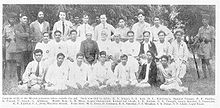 Portrait of 25 of Meerut Prisoners taken outside the jail. Backrow:(left to right) K.N. Sehgal, S.S. Josh, H.L. Hutchinson, Shaukat Usmani, B.F. Bradly, A. Prasad, Philip Spratt, and G. Adhikari. Middle Row: K.R. Mitra, Gopan Chakravarthy, Kishore Lal Ghosh, K.L. Kadam, D.R. Thengdi, Goura Shanker, S. Banerjee, K.N. Joglekar, P.C. Joshi, and Muzaffar Ahmed. Front Row: M.G. Desai, G. Goswami, R.S. Nimkar, S.S. Mirajkar, S.A. Dange, G.V. Ghate and Gopal Basak.
Portrait of 25 of Meerut Prisoners taken outside the jail. Backrow:(left to right) K.N. Sehgal, S.S. Josh, H.L. Hutchinson, Shaukat Usmani, B.F. Bradly, A. Prasad, Philip Spratt, and G. Adhikari. Middle Row: K.R. Mitra, Gopan Chakravarthy, Kishore Lal Ghosh, K.L. Kadam, D.R. Thengdi, Goura Shanker, S. Banerjee, K.N. Joglekar, P.C. Joshi, and Muzaffar Ahmed. Front Row: M.G. Desai, G. Goswami, R.S. Nimkar, S.S. Mirajkar, S.A. Dange, G.V. Ghate and Gopal Basak.
On March 20, 1929, arrests against WPP, CPI and other labour leaders were made in several parts of India, in what became known as the Meerut Conspiracy Case. The communist leadership was now put behind bars. The trial proceedings were to last for four years.[10][11]
As of 1934, the main centres of activity of CPI were Bombay, Calcutta and Punjab. The party had also begun extending its activities to Madras. A group of Andhra and Tamil students, amongst them P. Sundarayya, were recruited to the CPI by Amir Hyder Khan.[12]
The party was reorganised in 1933, after the communist leaders from the Meerut trials were released. A central committee of the party was set up. In 1934 the party was accepted as the Indian section of the Communist International.[13]
When Indian leftwing elements formed the Congress Socialist Party in 1934, the CPI branded it as Social Fascist.[7]
In connection with the change of policy of the Comintern toward Popular Front politics, the Indian communists changed their relation to the Indian National Congress. The communists joined the Congress Socialist Party, which worked as the left wing of Congress. Through joining CSP the CPI accepted the CSP demand for Constituent Assembly, which it had denounced two years before. The CPI however analysed that the demand for Constituent Assembly would not be a substitute for soviets.[14]
In July 1937, the first Kerala unit of CPI was founded at a clandestine meeting in Calicut. Five persons were present at the meeting, E.M.S. Namboodiripad, Krishna Pillai, N.C. Sekhar, K. Damodaran and S.V. Ghate. The first four were members of the CSP in Kerala. The latter, Ghate, was a CPI Central Committee member, who had arrived from Madras.[15] Contacts between the CSP in Kerala and the CPI had begun in 1935, when P. Sundarayya (CC member of CPI, based in Madras at the time) met with EMS and Krishna Pillai. Sundarayya and Ghate visited Kerala at several times and met with the CSP leaders there. The contacts were facilitated through the national meetings of the Congress, CSP and All India Kisan Sabha.[12]
In 1936-1937, the cooperation between socialists and communists reached its peak. At the 2nd congress of the CSP, held in Meerut in January 1936, a thesis was adopted which declared that there was a need to build 'a united Indian Socialist Party based on Marxism-Leninism'.[16] At the 3rd CSP congress, held in Faizpur, several communists were included into the CSP National Executive Committee.[17]
In Kerala communists won control over CSP, and for a brief period controlled Congress there.
Two communists, E.M.S. Namboodiripad and Z.A. Ahmed, became All India joint secretaries of CSP. The CPI also had two other members inside the CSP executive.[14]
On the occasion of the 1940 Ramgarh Congress Conference CPI released a declaration called Proletarian Path, which sought to utilize the weakened state of the British Empire in the time of war and gave a call for general strike, no-tax, no-rent policies and mobilising for an armed revolution uprising. The National Executive of the CSP assembled at Ramgarh took a decision that all communists were expelled from CSP.[18]
In July 1942, the CPI was legalised.[19] Communists strengthened their control over the All India Trade Union Congress. At the same time, communists were politically cornered for their opposition to the Quit India Movement.
CPI contested the Provincial Legislative Assembly elections of 1946 of its own. It had candidates in 108 out of 1585 seats. It won in eight seats. In total the CPI vote counted 666 723, which should be seen with the backdrop that 86% of the adult population of India lacked voting rights. The party had contested three seats in Bengal, and won all of them. One CPI candidate, Somanth Lahiri, was elected to the Constituent Assembly.[20]
Communism in India Communist Party of India
AITUC - AIKS - AIYF
AISF - NFIW - BKMUCommunist Ghadar Party of India
Naxalbari uprising
Communist Party of India (M-L)
Liberation - New Democracy
Janashakti - PCC - 2nd CC
Red Flag - Class Struggle
Communist Party of India (Maoist)Socialist Unity Centre of India (Communist)
AIUTUC - AIMSS
AIDYO - AIDSOM. N. Roy
Abani Mukherji
A. K. Gopalan
P. Krishna Pillai
P. C. Joshi
P. Sundarayya
Ajoy Ghosh
K. Damodaran
E. M. S. Namboodiripad
Chandra Rajeshwar Rao Azhikodan Raghavan
Bhupesh Gupta V. S. Achuthanandan
E. K. Nayanar
Guru Radha Kishan
B. T. Ranadive
Charu Majumdar
Jyoti Basu
S. A. Dange
Shibdas Ghosh
E. K. Imbichi Bava
T. Nagi ReddyTebhaga movement
CCOMPOSA
Telangana Rebellion
Comrades Association
Communist Party of French IndiaCommunism
World Communist MovementCommunism Portal In 1946 the party launched the Tebhaga movement in Bengal, a militant campaign against feudalism.
Communists after independence
During the period around and directly following Independence in 1947, the internal situation in the party was chaotic. The party shifted rapidly between left-wing and right-wing positions. In February, 1948, at the 2nd Party Congress in Calcutta, B.T. Ranadive (BTR) was elected General Secretary of the party.[21] The conference adopted the 'Programme of Democratic Revolution'. This programme included the first mention of struggle against caste injustice in a CPI document.[22]
In several areas the party led armed struggles against a series of local monarchs that were reluctant to give up their power. Such insurgencies took place in Tripura, Telangana and Kerala.[citation needed] The most important rebellion took place in Telangana, against the Nizam of Hyderabad. The Communists built up a people's army and militia and controlled an area with a population of three million. The rebellion was brutally crushed and the party abandoned the policy of armed struggle. BTR was deposed and denounced as a 'left adventurist'.
In Manipur, the party became a force to reckon with through the agrarian struggles led by Jananeta Irawat Singh. Singh had joined CPI in 1946.[23] At the 1951 congress of the party, 'People's Democracy' was substituted by 'National Democracy' as the main slogan of the party.[24]
In early 1950s young communist leadership was uniting textile workers, bank employees and unorganized sector workers to ensure mass support in north India. National leaders like S A Dange, Chandra Rajeswara Rao and P K Vasudevan Nair were encouraging them and supporting the idea despite their differences on the execution of these plans. Firebrand Communist leaders like Homi F Dazi, Guru Radha Kishan, H L Parwana, Sarjoo Pandey, Darshan Singh Canadian and Avtaar Singh Malhotra were emerging between the masses and the working class in particular. This was the first leadership of communists that was very close to the masses and people consider them champions of the cause of the workers and the poor. In Delhi, May Day ( majdoor diwas or mai diwas) was organized at Chandni Chowk Ghantaghar in such a manner that demonstrates the unity between all the factions of working classes and ignite the passion for communist movement in the northern part of India.
Communist movement or CPI in particular emerged as a front runner after Guru Radha Kishan undertook a fast unto death for 24 days to promote the cause of textile workers in Delhi. Till than it was a public misconception that communists are the revolutionaries with arms in their hands and workers and their families were afraid to get associated with the communists but this act mobilize general public in the favor communist movement as a whole. During this period people with their families use to visit this 'dharna sthal' to encourage CPI cadre.
This model of selflessness for the society benefits worked for CPI far more than expected. This trend was followed by almost all other state units of party in hindi heartland. Communist Party related trade union AITUC became a prominent force to unite the workers in textile, municipal and unorganised sectors, the first labour union in unorganised sector was also emerged in the leadership of Comrade Guru Radha Kishan during this period in Delhi's Sadar Bazaar area. This movement of mass polarisation of workers in the favour of CPI worked effectively in Delhi and paved the way for great success of CPI in the elections in working class dominated areas in Delhi. Comrade Gangadhar Adhikari and E.M.S. Namboodiripad applauded this brigade of dynamic comrades for their selfless approach and organisational capabilities. This brigade of firebrand communists gained more prominence when Telangana Hero Chandra Rajeswara Rao raised as General Secretary of Communist Party of India.
In the general elections in 1957, the CPI emerged as the largest opposition party. In 1957, the CPI won the state elections in Kerala. This was the first time that an opposition party won control over an Indian state. E. M. S. Namboodiripad became Chief Minister. At the 1957 international meeting of Communist parties in Moscow, the Communist Party of China directed criticism at the CPI for having formed a ministry in Kerala.[25]
A serious rift within the party surfaced in 1962. One reason was the Sino-Indian War, where a faction of the Indian Communists backed the position of the Indian government, while other sections of the party claimed that it was a conflict between a socialist and a capitalist state, and thus took a pro-Chinese position. There were three factions in the party - "internationalists", "centrists", and "nationalists".[citation needed] "Internationalists", including B. T. Ranadive, P. Sundarayya, P. C. Joshi, Makineni Basavapunnaiah, Jyoti Basu, and Harkishan Singh Surjeet, supported the Chinese stand. The "nationalists", including prominent leaders such as S.A. Dange, A. K. Gopalan[citation needed] backed India. "Centrists" took a neutral view; Ajoy Ghosh was the prominent person in the centrist faction. In general, most of Bengal Communist leaders supported China and most others supported India [1]. Hundreds of CPI leaders, accused of being pro-Chinese, were imprisoned. Some of the nationalists were also imprisoned, as they used to express their opinion only in party forums, and CPI's official stand was pro-China.
Ideological differences lead to the split in the party in 1964 when two different party conferences were held, one of CPI and one of the Communist Party of India (Marxist). There is a common misconception that the rift during Sino-Indian war lead to the 1962 split.[citation needed] In fact, the split was leftists vs rightists, rather than internationalists vs nationalists.[citation needed] The presence of nationalists, and internationalists P. Sundarayya, Jyoti Basu, and Harkishan Singh Surjeet in the Communist Party of India (Marxist) proves this fact.
During the period 1970-77, CPI was allied with the Congress party. In Kerala, they formed a government together with Congress, with the CPI-leader C. Achutha Menon as Chief Minister. After the fall of the regime of Indira Gandhi, CPI reoriented itself towards cooperation with CPI(M).
In 1986, the CPI's leader in the Punjab and MLA in the Punjabi legislature Darshan Singh Canadian was assassinated by Sikh extremists.Then on 19May 1987 Com Deepak Dhawan General secretary of Punjab CPM was murdered. Altogether about 200 communist leaders out of which most were Sikhs were murdered by Sikh terrorists in Punjab.
Present situation
CPI is recognized by the Election Commission of India as a 'National Party'. To date, CPI happens to be the only national political party from India to have contested all the general elections using the same electoral symbol.
On the national level they supported the Indian National Congress-led United Progressive Alliance government, but without taking part in it. The party is part of a coalition of leftist and communist parties known in the national media as the Left Front. Upon attaining power in May 2004, the United Progressive Alliance formulated a programme of action known as the Common Minimum Programme. The Left bases its support to the UPA on strict adherence to it. Provisions of the CMP mentions to discontinue disinvestment, massive social sector outlays and an independent foreign policy.
On July 8, 2008, Prakash Karat announced that left front is withdrawing its support over the decision by the government to go ahead on the United States-India Peaceful Atomic Energy Cooperation Act. The left front had been a staunch advocate of not proceeding with this deal citing national interests. [2]
In West Bengal it participates in the Left Front. It also participates in the state government in Manipur. In Kerala the party is part of Left Democratic Front. In Tripura the party is a partner of the governing Left Front, having a minister. In Tamil Nadu it is part of the Progressive Democratic Alliance. It is involved in the Left Democratic Front in Maharashtra
The current general secretary of CPI is Ardhendu Bhushan Bardhan.
The principal mass organizations of the CPI are:
- All India Trade Union Congress
- All India Youth Federation
- All India Students Federation
- National Federation of Indian Women
- All India Kisan Sabha (peasants organization)
- Bharatiya Khet Mazdoor Union (agricultural workers)
- All India State Government Employees Federation (State government employees)
Lok Sabha election tally
State No. of candidates 2004 No. of elected 2004 No. of candidates 1999 No. of elected 1999 Total no. of seats in the state Andhra Pradesh 1 1 6 0 42 Arunachal Pradesh 0 0 0 0 2 Assam 1 0 1 0 14 Bihar 6 0 9 0 40 (2004)/54(1999) Chhattisgarh 1 0 - - 11 (2004) Goa 2 0 2 0 2 Gujarat 0 0 1 0 26 Haryana 0 0 0 0 10 Himachal Pradesh 0 0 1 0 4 Jammu and Kashmir 0 0 0 0 6 Jharkhand 1 1 - - 14 (2004) Karnataka 0 0 0 0 28 Kerala 4 3 4 0 20 Madhya Pradesh 2 0 1 0 29 (2004)/40(1999) Maharashtra 1 0 2 0 48 Manipur 1 0 1 0 2 Meghalaya 0 0 2 0 2 Mizoram 0 0 0 0 1 Nagaland 0 0 0 0 1 Orissa 0 0 3 0 21 Punjab 1 0 1 1 13 Rajasthan 2 0 4 0 25 Sikkim 0 0 0 0 1 Tamil Nadu 2 2 2 0 39 Tripura 0 0 0 0 2 Uttar Pradesh 6 0 11 0 80 (2004)/85 (1999) Uttaranchal 0 0 - - 5 (2004) West Bengal 3 3 3 3 42 Union Territories Andaman & Nicobar 0 0 0 0 1 Chandigarh 0 0 0 0 1 Dadra and Nagar Haveli 0 0 0 0 1 Daman and Diu 0 0 0 0 1 Delhi 0 0 0 0 7 Lakshadweep 0 0 0 0 1 Pondicherry 0 0 0 0 1 Total: 34 10 54 4 543 State election results
State No. of candidates No. of elected Total no. of seats in Assembly Year of Election Andhra Pradesh 12 6 294 2004 Assam 19 1 126 2001 Bihar 153 5 324 2000 Chhattisgarh 18 0 90 2003 Delhi 2 0 70 2003 Goa 3 0 40 2002 Gujarat 1 0 181 2002 Haryana 10 0 90 2000 Himachal Pradesh 7 0 68 2003 Jammu and Kashmir 5 0 87 2002 Karnataka 5 0 224 2004 Kerala 22 17 140 2006 Madhya Pradesh 17 0 230 2003 Maharashtra 19 0 288 1999 Manipur 16 4 60 2006 Meghalaya 3 0 60 2003 Mizoram 4 0 40 2003 Orissa 6 1 147 2004 Pondicherry 2 0 30 2001 Punjab 11 0 117 2006 Rajasthan 15 0 200 2003 Tamil Nadu 8 6 234 2006 Tripura 2 1 60 2003 Uttar Pradesh 5 0 402 2002 Uttaranchal 14 0 70 2002 West Bengal 13 8 294 2006 Results from the Election Commission of India website. Results do not deal with partitions of states (Bihar was bifurcated after the 2000 election, creating Jharkhand), defections and by-elections during the mandate period.
See also
See also: List of political parties in India, Politics of India, List of Communist Parties
- Communist Ghadar Party of India
- Communist Party of Bangladesh
- Pandit Karyanand Sharma
- Indradeep Sinha
- Indrajit Gupta
- Guru Radha Kishan
- Azhikodan Raghavan
- Darshan Singh Canadian
- Chandrashekhar Singh
- Singaravelu Chettiar
- S A Dange
References
- ^ M.V. S. Koteswara Rao. Communist Parties and United Front - Experience in Kerala and West Bengal. Hyderabad: Prajasakti Book House, 2003. p. 88-89
- ^ Ganguly, Basudev. S.A. Dange - A Living Presence at the Centenary Year in Banerjee, Gopal (ed.) S.A. Dange - A Fruitful Life. Kolkata: Progressive Publishers, 2002. p. 63.
- ^ M.V. S. Koteswara Rao. Communist Parties and United Front - Experience in Kerala and West Bengal. Hyderabad: Prajasakti Book House, 2003. p. 89
- ^ a b Ralhan, O.P. (ed.) Encyclopedia of Political Parties New Delhi: Anmol Publications p. 336, Rao. p. 89-91
- ^ M.V. S. Koteswara Rao. Communist Parties and United Front - Experience in Kerala and West Bengal. Hyderabad: Prajasakti Book House, 2003. p. 92-93
- ^ M.V. S. Koteswara Rao. Communist Parties and United Front - Experience in Kerala and West Bengal. Hyderabad: Prajasakti Book House, 2003. p. 111
- ^ a b Saha, Murari Mohan (ed.), Documents of the Revolutionary Socialist Party: Volume One 1938-1947. Agartala: Lokayata Chetana Bikash Society, 2001. p. 21-25
- ^ M.V. S. Koteswara Rao. Communist Parties and United Front - Experience in Kerala and West Bengal. Hyderabad: Prajasakti Book House, 2003. p. 47-48
- ^ M.V. S. Koteswara Rao. Communist Parties and United Front - Experience in Kerala and West Bengal. Hyderabad: Prajasakti Book House, 2003. p. 97-98, 111-112
- ^ Ralhan, O.P. (ed.). Encyclopaedia of Political Parties - India - Pakistan - Bangladesh - National -Regional - Local. Vol. 23. Revolutionary Movements (1930-1946). New Delhi: Anmol Publications, 2002. p. 689-691
- ^ M.V. S. Koteswara Rao. Communist Parties and United Front - Experience in Kerala and West Bengal. Hyderabad: Prajasakti Book House, 2003. p. 96
- ^ a b E.M.S. Namboodiripad. The Communist Party in Kerala - Six Decades of Struggle and Advance. New Delhi: National Book Centre, 1994. p. 7
- ^ Surjeet, Harkishan Surjeet. March of the Communist Movement in India - An Introduction to the Documents of the History of the Communist Movement in India. Calcutta: National Book Agency, 1998. p. 25
- ^ a b Roy, Samaren. M.N. Roy: A Political Biography. Hyderabad: Orient Longman, 1998. p. 113, 115
- ^ E.M.S. Namboodiripad. The Communist Party in Kerala - Six Decades of Struggle and Advance. New Delhi: National Book Centre, 1994. p. 6
- ^ E.M.S. Namboodiripad. The Communist Party in Kerala - Six Decades of Struggle and Advance. New Delhi: National Book Centre, 1994. p. 44
- ^ E.M.S. Namboodiripad. The Communist Party in Kerala - Six Decades of Struggle and Advance. New Delhi: National Book Centre, 1994. p. 45
- ^ Ralhan, O.P. (ed.). Encyclopedia of Political Parties - India - Pakistan - Bangladesh - National -Regional - Local. Vol. 24. Socialist Movement in India. New Delhi: Anmol Publications, 1997. p. 82
- ^ Surjeet, Harkishan Surjeet. March of the Communist Movement in India - An Introduction to the Documents of the History of the Communist Movement in India. Calcutta: National Book Agency, 1998. p. 55
- ^ M.V. S. Koteswara Rao. Communist Parties and United Front - Experience in Kerala and West Bengal. Hyderabad: Prajasakti Book House, 2003. p. 207.
- ^ Chandra, Bipan & others (2000). India after Independence 1947-2000, New Delhi:Penguin, ISBN 0-14-027825-7, p.204
- ^ Microsoft Word - Texte Christop
- ^ The Telegraph - Calcutta : Northeast
- ^ E.M.S. Namboodiripad. The Communist Party in Kerala - Six Decades of Struggle and Advance. New Delhi: National Book Centre, 1994. p. 273
- ^ Basu, Pradip. Towards Naxalbari (1953-1967) – An Account of Inner-Party Ideological Struggle. Calcutta: Progressive Publishers, 2000. p. 32.
External links
- Communist Party of India web site
- Communist Ghadar Party of India web site
- Leftism in India, 1917-1947 by Satyabrata Rai Chowdhuri, Palgrave, UK, 2007.
- Assorted CPI-related images
Categories:- Political parties established in 1920
- Communist parties in India
- Communist Party of India
- 1920 establishments in India
Wikimedia Foundation. 2010.

